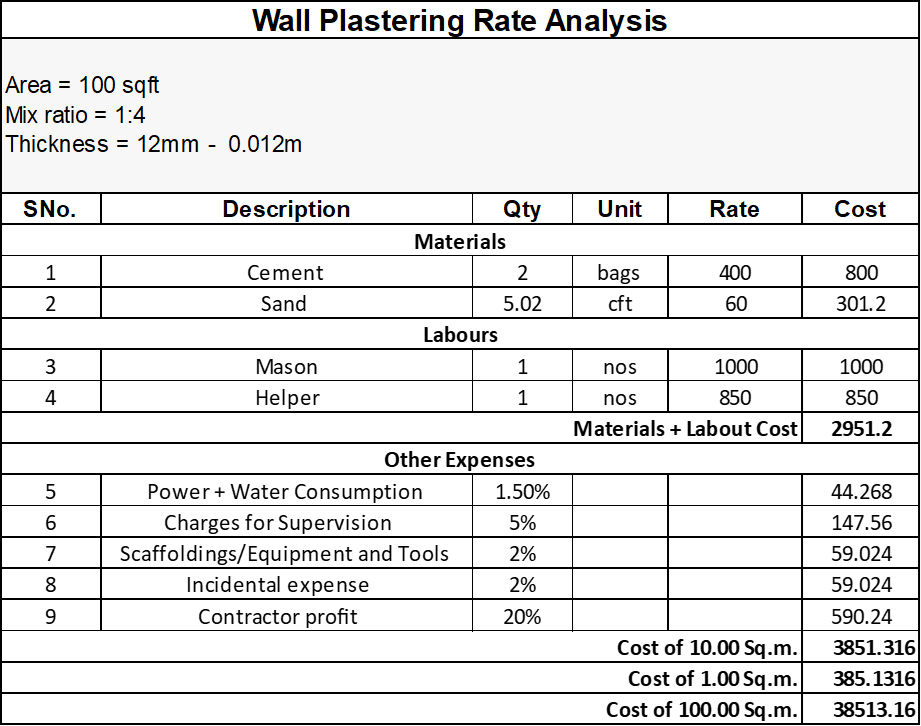Plastering is a thin layer of mortar (Cement & sand mixed with water, which makes plaster material) that is applied over brick or block masonry and acts as a wet-proof coat on brickwork/blockwork.
Also read: Rate analysis for plastering work - Estimating and Costing of Material and labour
Plastering provides
1. It improves the appearance
of the building.
2. Protect the surface from weather
influences,
3. Conceal porous materials
4. Provide a suitable surface
for painting.
5. Helps cover the defective
workmanship in masonry
Also read: Plastering
Mix Ratio | things you want to know about wall plastering
Internal Plastering Cost per
square foot with material
For internal plastering, we
should take a 1:5
ratio as the mix ratio and 12 to 15mm thickness. Using our Plastering
Material Calculator excel sheet we have data for a 100 sqft wall area
We need 2 bags of cement
and 6.5cft sand for 100 sqft Internal Plastering
Internal Plastering Rate Analysis
So, the cost of the internal
plastering of 12mm is 396/sqm – 400/sqm
Also use: PLASTERING
MATERIAL COST CALCULATOR
External Plastering Cost per
square foot with material
For External plastering, we
should take a 1:6
ratio as the mix ratio and 15 to 18mm thickness. Using our Plastering
Material Calculator excel sheet we have data for a 100 sqft wall area
We need 1 bag of cement and 6.7 cft sand for 100
sqft External plastering
External Plastering Rate Analysis
So, the cost of the external plastering is 346/sqm – 350/sqm
Ceiling Plastering Cost per
square foot with material
For Ceiling plastering, we
should take a 1:4
ratio as the mix ratio and 10 to 12mm thickness. Using our Plastering
Material Calculator excel sheet we have data for a 100sqft wall area
We need 2 bags of cement
and 5.02cft sand for 100 sqft internal plastering
Ceiling Plastering Rate Analysis
So, the cost of the Ceiling
plastering of 12mm is 385/sqm – 390/sqm
Also use: PLASTERING
MATERIAL COST CALCULATOR
Water Proofing Plastering Cost
per square foot with material
For Water Proofing plastering, we
should take a 1:3
ratio as the mix ratio and 12 to 18mm thickness. Using our Plastering
Material Calculator excel sheet we have data for a 100 sqft wall area
We need 2 bags of cement and 4.7 cft sand and 1 litre Dr
Fixit LW+ for 100 sqft Water Proofing Plastering
Water Proofing Plastering Rate Analysis
So, the cost of the Water
Proofing of 12mm is 417/sqm – 420/sqm
Rough Plastering (used for wall
tiles) Cost per square foot with material
For Rough plastering, we
should take a 1:5
ratio as the mix ratio and 12mm thickness. Using our Plastering
Material Calculator excel sheet we have data for 100sqft wall area\
We need 1 bag of cement and 5.2 cft sand for 100 sqft Rough Plastering
Rough Plastering Rate Analysis
So, the cost of the Rough plastering of 12mm is 334/sqm – 340/sqm
FAQ
What is the rate of plaster?
Type of Plastering | Rate/sqft | |
Minimum | Maximum | |
Internal Plastering | 346 | 350 |
External Plastering | 396 | 400 |
Ceiling Plastering | 385 | 390 |
Water proof Plastering | 417 | 420 |
Rough Plastering | 334 | 340 |
The above rate of plastering varies from place to place and this value is made on 2022
What should be done after
plaster work on the wall?
1. After completion of work it
is necessary to clean the doors or frame and floor area.
2. Curing begins 24 hours
after the plaster is applied.
3. Curing should begin once
the plaster has sufficiently hardened and cured for at least 7 days.
What is the recommended
thickness of cement plaster?
For Single coat plaster use 10
to 15mm thickness,
For undercoat for two coat plaster
use 10 to 12mm thickness,
Finishing coat for two coat plaster
use 3 to 8mm thickness,
Base coat for Three coat plaster
use 10 to 15mm thickness
Second coat for Three coat plaster
use 3 to 8mm thickness
Finishing coat for Three coat plaster use 3 to 5mm thickness
What is the ratio of sand and
cement in the Waterproof plastering of a bathroom?
The most commonly used and preferred mix for the Waterproof plastering of a bathroom is 1:3 ( 1 cement : 3 fine sand)












Good!This post is creative,you'll find a lot of new idea,it gives me inspiration.
ReplyDeleteI believe I will also inspired by you and feel about extra new ideas. thanks.